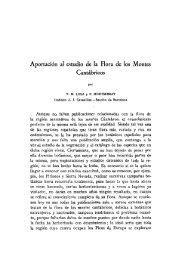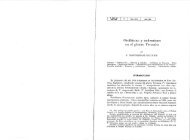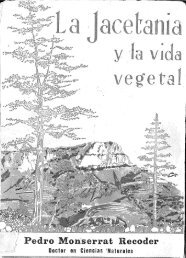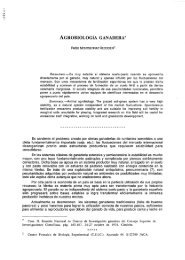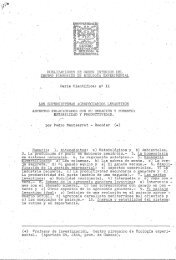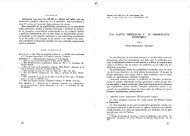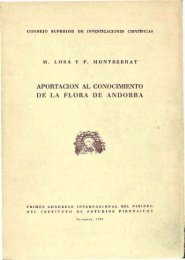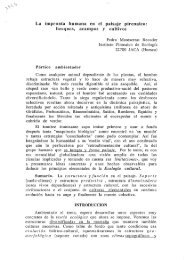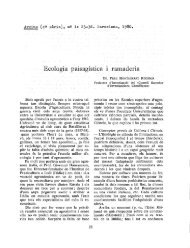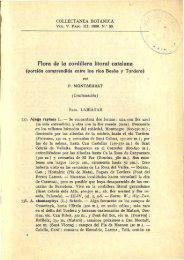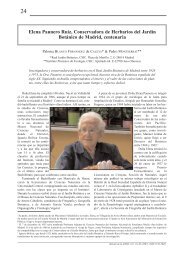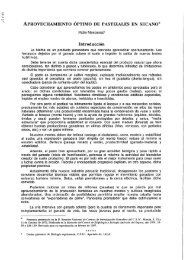the systems of grassland management in spain - Publicaciones del ...
the systems of grassland management in spain - Publicaciones del ...
the systems of grassland management in spain - Publicaciones del ...
Create successful ePaper yourself
Turn your PDF publications into a flip-book with our unique Google optimized e-Paper software.
44animal husbandry <strong>in</strong> <strong>the</strong> past and also its futurepossibilities.Soil evolution <strong>in</strong> different habitatsIt seems necessary to consider not only <strong>the</strong>climatic and topographical frames with<strong>in</strong> whichsoil develops but also <strong>the</strong> type <strong>of</strong> rock which forms<strong>the</strong> parent materia!.In siliceous zones <strong>of</strong> Spa<strong>in</strong>, and also <strong>in</strong> a part <strong>of</strong>Portugal, <strong>the</strong> so-calIed "Escudo Hespérico" withPalaeozoic mounta<strong>in</strong>s is formed ma<strong>in</strong>ly <strong>of</strong>siliceousrocks (Galicia, Montes de León, Sierras de Gredosand Guadarrama, Oretana 01' Montes de Toledo,and Sierra Morena), and this is most evident on <strong>the</strong>Cambrian slates 01' <strong>in</strong> <strong>the</strong> granitic regions. Mounta<strong>in</strong>crests where quartz is present <strong>in</strong> quantity haveresisted erosion, but <strong>the</strong> soil is very pOOl". TheSpanish oak (QlIerclIs pyrenaica) <strong>in</strong> <strong>the</strong>se areaseffectively mobilizes and retaios m<strong>in</strong>eral cationswhich would o<strong>the</strong>rwise be lost to <strong>the</strong> pastureland,and thus helps to form <strong>the</strong> grazed bardal, a verytypical k<strong>in</strong>d <strong>of</strong> Spanish westem <strong>grassland</strong>s.Hard limestone rocks, which form cliffs andstony mounta<strong>in</strong> crests, provide a suitable base for<strong>the</strong> deep-rooted legumes so sought by sheep.Mixed woods evolve at <strong>the</strong> base <strong>of</strong> <strong>the</strong>se cliffs.They are rich <strong>in</strong> a variety <strong>of</strong> species and readilylend <strong>the</strong>mselves to pastoral exploitation. Thefrequency <strong>of</strong> alternat<strong>in</strong>g areas <strong>of</strong> marl, sandstoneand conglomerates favours diversity <strong>of</strong> soH typesand <strong>the</strong> different k<strong>in</strong>d <strong>of</strong> pastures which may befound <strong>in</strong> valleys dedicated to graz<strong>in</strong>g.F<strong>in</strong>ally, <strong>the</strong> geological deposition <strong>of</strong> evaporites<strong>in</strong> <strong>the</strong> wide valleys <strong>of</strong> Aragón, La Rioja and LaMancha has helped to preserve a very speeializedfiora, adapted to <strong>the</strong> presence <strong>of</strong> both gypsum andsalt. The large quantity <strong>of</strong> gypsum prevents <strong>the</strong>formation <strong>of</strong> black alkali (sodium carbonate),which has had such a devastat<strong>in</strong>g effect on similarenvironments <strong>in</strong> o<strong>the</strong>r countries.Diversiflcation <strong>of</strong> pasture-landTak<strong>in</strong>g a broad view <strong>of</strong> <strong>the</strong> dynamics <strong>of</strong> (henatural vegetation and its development, especiallythat which has been subjected to erosion, recoveryand diversificatiol1, <strong>the</strong> extreme importance <strong>of</strong>suchdiversification can readily be understood.By observ<strong>in</strong>g <strong>the</strong> behaviour <strong>of</strong> gregarious animalsman leamt how best to make use <strong>of</strong> <strong>the</strong>sediversities. Gregarious ethology, and knowledge <strong>of</strong>PEDRO MONTSERRAT and FEDERICO FtLLAT<strong>the</strong> traditional methods <strong>of</strong> <strong>the</strong> past, both contributedto <strong>the</strong> development <strong>of</strong> graz<strong>in</strong>g land and alsoto <strong>the</strong> <strong>in</strong>tegration <strong>of</strong> <strong>the</strong> farmer with his surround¡ngs. For this reason it is necessary to describe <strong>the</strong><strong>in</strong>terplay between <strong>the</strong> animals and <strong>the</strong>ir habita t,whe<strong>the</strong>r <strong>in</strong> terms <strong>of</strong>plants and animals found <strong>the</strong>re01' geophysical conditions. Any given breed is <strong>the</strong>consequence <strong>of</strong> ¡ts evolution <strong>in</strong> a specific envirOllment.The group adapts by a process <strong>of</strong> selectionand <strong>the</strong> result<strong>in</strong>g genetical evolution. This means,with<strong>in</strong> any given mounta<strong>in</strong> habitat, that it ispossible to preserve those breeds that are not onlywell adapted but can be ma<strong>in</strong>ta<strong>in</strong>ed at a m<strong>in</strong>imumcostoAn historieal perspeetive <strong>of</strong> animal husbandry <strong>in</strong>Spa<strong>in</strong> (Fig. 3.5)The shepherd <strong>of</strong> <strong>the</strong> Neolithic revolution(Moore, 1981) leamt fram <strong>the</strong> wild fiocks. Nomadismand also fiock movements <strong>in</strong> <strong>the</strong> mom<strong>in</strong>g,rest<strong>in</strong>g at noon and sheepfold<strong>in</strong>g, have evolvedfrom <strong>the</strong> behaviour <strong>of</strong> wild animals. Similarly,gregariousness and graup life pass directly framanimals to menoWe present by maps (Fig. 3.5) <strong>the</strong> cultural<strong>in</strong>ftuences <strong>in</strong> Spa<strong>in</strong> from Neolithic times to <strong>the</strong>Middle Ages. Megalithism and "Campaniforme"culture carne fram Egypt to <strong>the</strong> Balearic Islandsand sou<strong>the</strong>m Spa<strong>in</strong>. In Fig. 3.5A we show a range<strong>of</strong> <strong>the</strong>se <strong>in</strong>fiuences fram 4000 years ago. Megalith¡sro was very rare <strong>in</strong> central Spa<strong>in</strong>.From 2000 RC until <strong>the</strong> beg<strong>in</strong>n<strong>in</strong>g <strong>of</strong>Roman<strong>in</strong>ftuence (200 B.C.) <strong>the</strong>re was a cont<strong>in</strong>uous fiow <strong>of</strong><strong>in</strong>ftuences from <strong>the</strong> Near East (Phoenicians,Greeks) to eastem and sou<strong>the</strong>m Spa<strong>in</strong> (Fig. 3.5B)and also fram <strong>the</strong> northwest <strong>of</strong> Africa (Argarculture). Before <strong>the</strong> Romans carne to Spa<strong>in</strong>(900-650 RC.), <strong>the</strong> Celts <strong>in</strong>fiuenced Spa<strong>in</strong>, ma<strong>in</strong>ly<strong>in</strong> <strong>the</strong> northwest. In our map we outl<strong>in</strong>e approximately<strong>the</strong> zones <strong>of</strong> <strong>in</strong>fiuence and <strong>the</strong>ir limits.Romanization was ¡ntense <strong>in</strong> eastern Spa<strong>in</strong> andAndalucía (Fig. 3.5C), develop<strong>in</strong>g <strong>the</strong> agricnlturaltechniques founded <strong>in</strong> <strong>the</strong> villa organization <strong>of</strong> <strong>the</strong>conntry (this is found typicalIy <strong>in</strong> <strong>the</strong> mas <strong>of</strong> <strong>the</strong>nor<strong>the</strong>ast and <strong>the</strong> cortijo <strong>in</strong> sou<strong>the</strong>m Spa<strong>in</strong>).Roman penetration to <strong>the</strong> west <strong>of</strong> <strong>the</strong> Pen<strong>in</strong>sula(Evora and Mérida) was slow and only veryscattered, limited to m<strong>in</strong>es or <strong>the</strong>rmal waters <strong>in</strong>central Ol' nol'<strong>the</strong>rn Spa<strong>in</strong>. W<strong>in</strong>e and cereals wcrc



